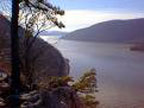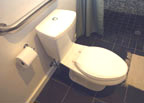Access to accessible, safe water has been recognized as a human right. But natural forces - and increasingly human decisions - have made it so this right is unattainable for massive numbers of people, not to mention for the innumerable creatures we share the planet with. With increasing global warming it is expected that weather patterns will grow more erratic, and recent predictions put the percentage of the planet experiencing "extreme drought" at 30% by the year 2100, up from the current 3%.

|
|
A view of the Hudson River
|
The Mid-Hudson Valley tends to seem quite lush and even in years when there are droughts people tend not to be concerned about water shortages. But looks can be deceiving. During the recent drought that peaked in 2002, the water level of the Ashokan Reservoir was so low that the stone foundations of historic villages that were flooded when the reservoir was created could be seen. And the population in the area continues to grow at a dramatic pace - it was more than 10% in the last decade.
Our water destiny is intimately related to a very thirsty neighbor to the south as well - New York City. We are well within the City's watershed, where 1900 square miles provide 1.4 billion gallons of water each day to nearly 9 million people.
It's All About the Toilets
A full 40% of the water used in homes is flushed down the toilet. So that is the first place we need to look if we are concerned about saving water. And the good news is that there is a lot we can do pretty easily.

|
|
A dual flush toilet from Sterling. The button on the top allows one to chose between a smaller and larger flush.
|
The Common Fire building will use about 37% less water than a comparable building thanks primarily to dual-flush toilets. These are toilets that offer a choice of a large or small flush. The large flush is itself less than most typical toilet flushes (at 1.6 gallons), yet the small flush (.8 gallons) is all you need most of the time. Using a dual flush toilet saves a typical family of four 6,000 gallons of water each year compared to the standard 2 gallon toilets installed these days, and far more compared to older more inefficient models.
Composting toilets tend to use no water, though some models use a small amount of water or foam. These toilets use biological processes to break down human waste into organic compost material, which can be used as a fertilizer. There are many different types of composting toilets, ranging in storage capacity and complexity. When we were deciding what type of toilets to use, we received mixed reports about composting toilets. The cost and the maintenance required, combined with the fact that it is illegal in our area to use the fertilizer produced, meaning that we would have to find a way to dispose of it, was a deterrent. Also we have our own septic field and well, so the water brought into the building to flush toilets would eventually be returned to the land surrounding the building. This results in a much smaller net water usage than a building using city/town water and pumping their waste water to a plant for processing.
Using an intentional wetland is an innovative way to collect, treat and dispose of waste water. Wetlands are the most biologically productive ecosystems on earth. The many plants and animals that live there can utilize the nutrients that occur in waste water and transform the waste pollution into harmless by-products. There is a growing interest in using intentional (also called engineered) wetlands to process waste water from towns and housing developments, for it is also a way to preserve open space and natural wildlife habitats. We were excited by the idea of an intentional wetland for our building, but in the end decided against it. It was unclear if the county board of health would approve it, and if they did they would only let us reduce the size of the septic field by half at most. Having a septic field already meant that we did not have to pump our waste water to a treatment plant where it would be highly chemically processed, a main reason for developing intentional wetlands. North American Wetland Engineering (NAWE) is a company out of Minnesota that came highly recommended to us when we were considering an intentional wetland.
Water Efficient Fixtures and Appliances

|
|
Kenmore Elite Oasis Canyon Capacity top-load washer and dryer
|
We installed aerators in most of the faucets in the building to increase their efficiency (they inject air into the water so you get the same pressure but less volume) and we're experimenting with a variety of low-flow shower heads. We are big fans of those simple valves that allow people to reduce or cut the shower flow while sudsing up, without affecting the temperature when you flip it back on. We use an Energy Star and water-efficient dishwasher and washing machine, provided by Kenmore. (In our experience no dishwasher is able to take care of all dishes without some rinsing. But "experts" report that using a dishwasher does indeed save water.)
Plant For the Climate Where You Live
About 1/3 of residential outdoor water use goes to lawns and landscape maintenance. (A lot of the rest goes to washing cars, maintaining swimming pools, spraying sidewalks and driveways.) This can be largely or completely avoided by selecting only those plants that are adapted to the local climate and are drought resistant. Our landscaping plants were donated by a local nursery The Phantom Gardener.
The Common Fire building has zero permanent irrigation. (Some watering of transplanted trees and shrubs may be necessary for the first few years in the summer until they are established.)
Continue the tour: Site Selection

